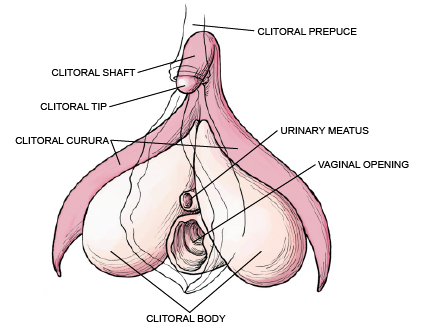Anatomy and Function
The clitoris (C-Point) is part of the vulva and thus belongs to a woman's external genitalia. Apart from the clitoral tip the majority of the clitoris is embedded in the vulva's tissue. From an evolutionary point of view, the clitoris shows many similarities to a man's penis. All female mammals have a clitoris and it is known as the only organ which only serves pleasure. [1] [2] [3]
The exact makeup of the clitoris became known in 1998 by the Australian researcher and urologist Dr. Helen O'Connell. She recognized the similarities to male cavernous bodies and suggested to rename the organ into clitoris complex. [1] [2] It consists of the following parts:
The clitoral tip is formed by the glans (Glans clitoridis) and the shaft (Corpus clitoridis) and stands out visibly like a bud between the labia majora. There are more nerve ends than in the glans penis, thus pressure, movement but also pain are felt more intensely. The clitoral tip is protected by the clitoral prepuce (Praeputium clitoridis). [1] [2] [3] [CLITORAL PREPUCE]
The clitoral body which is composed of two erectile bodies known as the corpora cavernosa (Corpus cavernosum clitoridis) is arched and is divided into two clitoral crura (Crus clitoridis) which are situated along the pubic branches. The crura can be around nine centimeters long. The vestibular bulbs (Bulbus vestibuli) surround a major part of the urethra and the anterior third of the vagina. [2] [4]
During the response to sexual arousal all clitoral parts fill with blood and – homologous to the corpus cavernosum penis in the male – become more sensitive to touch and pressure. Additionally, there is a muscular pumping system (Musculus ischiocavernosus, Musculus bulbospongiosus), which helps to provide the corpus cavernosum with blood. Current MRI (magnetic resonance imaging) studies [4] show that the clitoral tissue doubles in size when aroused. [2] [4] [5]

CC0 // Wikipedia
List of sources:
https://commons.wikimedia.org/wiki/File:Clitoris_anatomy_unlabeled.jpg#/media/File:Clitoris_anatomy_unlabeled.jpg
Sexuality
Since the clitoris forms a great part of the vulva and vagina, its exact role in sexual arousal is hard to define. Many women achieve orgasm through stimulation of the external clitoral glans (glans clitoridis) which sometimes is also called C-Point. [2] [POINTS OF INTERESTS]
Culture
Over the course of millenniums, the mystery around female pleasure and the clitoris has always been a (re-)discovery. In Antiquity, the similarities between men and women were already explored. Sexuality was regarded a penetrative, male-dominated act. From this perspective lesbians could only have sex when one of the women had an outsized clitoris. [3]
In medieval times, the clitoris vanished in oblivion. In "De re anatomica" (1599) Matteo Renaldo Colombo, a researcher and professor for surgery at the University of Padua, Italy, described the clitoris as "place of female happiness".
"If it is permissible to give names to things discovered by me, it should be called the love or sweetness of Venus." [3]
However, the term "Venus' love or sweet" hasn't gained acceptance. Colombo's statements were strongly discussed among his colleagues, since the clitoris wasn't regarded an organ of pleasure. For a long time it was common to trim women's outsized clitorides at the request of husbands. This tradition has survived in some cultures up to today. [3] [FEMALE CIRCUMCISION]
As part of the sexual revolution the groundbreaking works by Alfred Kinsey [HETEROSEXUALITY] and by Masters & Johnson* overshadowed the new discoveries of the clitoris. Only Helen O'Connell's research findings in 1998 developed a comprehensive picture of the clitoris which slowly but surely gained acceptance in medicine and media. [3]
Further Links:
Klitoris - Die Schöne Unbekannte (Arte Documentation), 2002 (Trailer)
* The American gynecologist William Howell Masters and his wife, the American scientist Virginia Johnson, pioneered with their studies on human sexual behavior. Together they published several books. The most familiar book is "The sexual reaction" (1967). [7]


